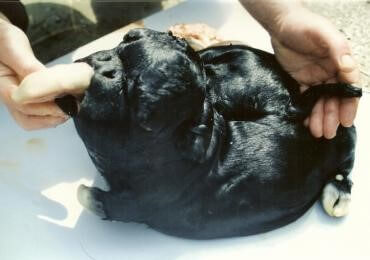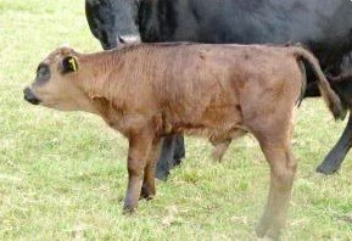Breeding Information
The Genetics of Defining Characteristics of the Dexter Breed
Some alleles are dominant over others, for example black hair is usually dominant over red. In this case red is said to be recessive. Therefore an animal carrying one or two black alleles will be black. The animal can only be red if it carries two red alleles
Other Alleles are said to be partially or incompletely dominant i.e. they effect the outcome but do not completely determine it. Dwarfing in Dexters is partially dominant. There are different outcomes for the individual if it has two, one or no dwarfing allele.
Dwarfing
Any Dexter alive at birth which is a dwarf carries one dwarfing allele and one non dwarfing allele on the gene which controls dwarfing. If the animal inherits two dwarfing alleles it will be what is known as a bulldog and will be dead and aborted at or before seven months. It will have hair but virtually no legs or upper jaw. If the aborted fetus is hairless the calf is likely to have a separate genetic condition known as PHA rather than dwarfism.
If the individual gets one dwarfing allele and one non dwarfing allele the animal will be what is known within the breed as a short. If the animal does not carry a dwarfing allele it is generally referred to as a non short or long. However terms like long, short, medium, short non carrier, non short etc are not clearly defined and have different meanings to different people. The terms, carrier or non carrier of the dwarfing allele are definite.
There is a reliable test available through the Dexter Cattle Society to determine whether or not an animal carries a dwarfing allele.
It was understood and recorded over 100 years ago that breeders in Ireland did not breed Dexters to Dexters in order to avoid bulldogs.
As with all heredity each parent will pass one of the the two alleles it carries to it’s offspring. If neither parent carries the dwarfing gene the calf cannot be a dwarf. If only one parent carries a dwarfing allele there is a 50% chance that the dwarfing allele is the one that will be passed i.e. there is a 50% chance that the offspring will be a dwarf.
There is no good reason to breed a dwarf to a dwarf. It does not increase the chances of producing a dwarf and it runs a 25% risk of producing a bulldog which not only results in unnecessary distress to all involved but also potentially to physical damage to the dam and to the financial loss of keeping an idle cow for a year.
You may hear people calling the dwarfing allele in Dexters a lethal recessive. Both of these words are inaccurate. The allele is partially or incompletely dominant. While an animal that gets two dwarfing alleles will not survive, an individual with one dwarfing allele can live a full and healthy life and is a true Dexter.
Join the Irish Dexter Cattle Society
Colour
The two colours originally recognised within the Dexter breed are red and black. Later a third colour, dun, was accepted into the breed. The colour Dun was accepted into the breed in the seventies.
Dun is widely believed to have come into the breed through introgression of non Dexter blood into the breed. The primary colour gene in the Dexter has two principal alleles, red and black.
Black is dominant to red so an animal with two black alleles or one black and one red allele will be black. An individual with two red alleles will always be red.
This is an accurate but simplified version of inheritance of red and black hair in Dexters. There are in fact two red alleles, red and wild red.
Wild red is dominant to red and an animal carrying two red alleles where one or both are wild red will be darker red with areas around the head and neck and the lower part of the legs being black). Other complications such as skin colour also exist.
On a separate gene a recessive allele exists which results in dilution of the colour black. If the animal carries two dun alleles on this gene and one or two black alleles on the primary colour gene the animal will be dun i.e. it would be a black animal in the absence of the two dun alleles.
Polling
Dexters are a horned breed. Polling within the breed is not as a result of a mutation. It has been introduced from two principal sources, Aberdeen Angus and Red Poll. Red poll is also believed to be the source of the dun colour. The Red Poll breed was created by crossing Suffolk Dun and Norfolk Red. Because Red Poll is a red breed, dun within the breed would not show up. However when combined with a breed like Dexter which carries black the dun can reappear. The Suffolk Dun breed is extinct.
The gene affecting polling has two possible alleles. They are polled or horned. Polling is dominant. This means that a polled animal can be carrying 2 polled alleles in which case all of it’s offspring will be polled or it can carry one polled allele and one horned allele in which case there is a 50% chance that it will pass a polled gene to it’s offspring.
There are other genes affecting horns. They can only affect the animal if it is polled. One such gene controls scur or wobble horns. These horns are usually small weak and detached from the skull. Sometimes, as the animal matures they become attached to the skull. Cleanly polled breeds such as Aberdeen Angus took decades to eliminate scurring from the breed. Scurring is not uncommon in Dexters and is more apparent in some blood lines. The same lines carry dun. This should not be confused with a badly dehorned animal. If an animal has been badly dehorned there may be some horn regrowth. This regrowth is usually of a non standard shape whereas wobble horns are normally shaped but weak and often not properly attached to the head.
There is another type of horns, known as African horns, which can only show up in a polled animal. African horns are sex linked. If a male carries one or two alleles for African horns and it carries a polling allele the African horns will manifest.
If both parents carry the dwarfing gene there is a 25% chance that the calf will receive no dwarfing gene from either parent and will be a non carrier. There is a 25% chance that it will receive the dwarfing gene from both parents and a bulldog will result. There is a 50% chance that the individual will receive one dwarfing and one non dwarfing allele and will be a dwarf.
There is no good reason to breed a dwarf to a dwarf. It does not increase the chances of producing a dwarf and it runs a 25% risk of producing a bulldog which not only results in unnecessary distress to all involved but also potentially to physical damage to the dam and to the financial loss of keeping an idle cow for a year.
You may hear people calling the dwarfing allele in Dexters a lethal recessive. Both of these words are inaccurate. The allele is partially or incompletely dominant. While an animal that gets two dwarfing alleles will not survive, an individual with one dwarfing allele can live a full and healthy life and is a true Dexter.






